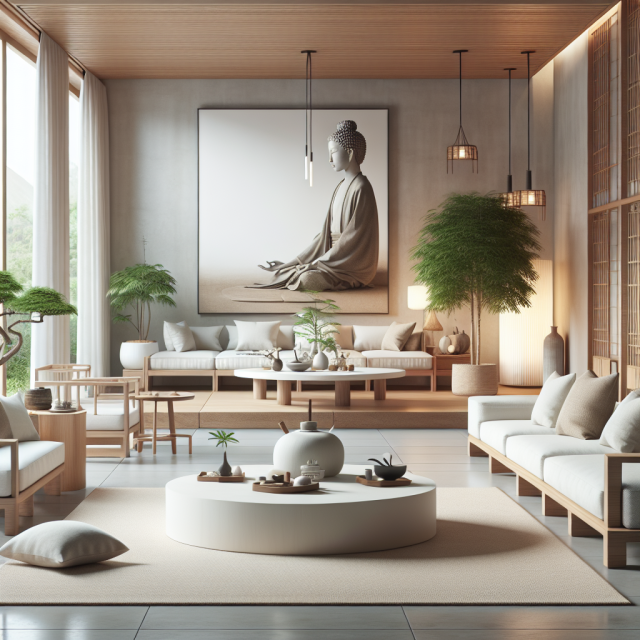
Breathe Easy: Design Strategies for a Zen Living Room Experience
Creating a zen living room that fosters relaxation, serenity, and peace is an investment not just in aesthetics but in your overall well-being. Our homes should reflect tranquility, allowing for mindfulness and a calming atmosphere. Here are design strategies to help you achieve a zen-inspired living room experience.
1. Choose a Neutral Color Palette
A primary cornerstone of zen design is color. To cultivate a peaceful ambiance, select a soft, neutral color palette. Shades of white, beige, soft gray, or muted earth tones can create a soothing atmosphere. These colors encourage a sense of calm and serve as a blank canvas for your space.
Tip: To avoid a cold feel, incorporate textured fabrics like woven throws, cushions, and rugs in your chosen color scheme. They will add warmth and depth without disrupting the harmonious essence you’re trying to create.
2. Integrate Natural Elements
Bringing nature indoors is integral to achieving a zen space. Incorporate plants, natural woods, and stone elements to create a serene environment. Indoor plants not only purify the air but also instill a sense of tranquility.
Tip: Consider using low-maintenance plants like succulents, snake plants, or peace lilies. These greens can thrive even in low-light areas, adding vibrant life and enhancing your room’s feng shui.
3. Simplified Furniture Arrangement
Consider the flow of movement within your space. A zen living room is typically free of clutter and distractions, which means minimalistic furnishing is essential. Select furniture that’s functional yet aesthetically pleasing.
Tip: Arrange your seating to encourage conversation and connection while maintaining ample space for moving around. A circular seating arrangement can be very inviting and conducive to an open atmosphere.
4. Embrace Minimalism
Less is more when creating a zen living room. A minimalist approach reduces distractions and fosters a more serene environment. Avoid overcrowding the space with furniture or decorations.
Tip: Limit decorative items to a few meaningful pieces—maybe a serene piece of art, a calming sculpture, or an organic-shaped vase. These thoughtful inclusions should evoke peace and reflect your personality without overwhelming the senses.
5. Create a Cozy Nook
A zen experience often involves a quiet corner for meditation, reading, or simply unwinding after a busy day. Designate a spot in your living room for this purpose.
Tip: Use soft cushions, a dedicated chair, or even a small floor cushion surrounded by fabrics in your chosen colors. Add a soft throw and some ambient lighting to create an inviting atmosphere.
6. Texture and Layering
Utilize a range of textures to create interest while still promoting the calming qualities of your zen space. Layer rugs, throws, and pillows to provide a cozy feel without cluttering.
Tip: Combine materials such as wool, cotton, linen, and jute. You can have a jute rug as a base and layer it with a softer fabric to create contrast and comfort.
7. Ambient Lighting
Proper lighting can transform your living room into a tranquil oasis. Harsh lighting can create stress, while soft, ambient lighting can foster relaxation.
Tip: Use a combination of floor lamps, table lamps, and dimmable lights to brighten or soften the atmosphere as needed. Consider adding candles or string lights for additional warmth and to enhance the meditative feel.
8. Incorporate Sound
Zen living rooms should also tickle the auditory senses. The calming sound of water, such as a small indoor fountain, can enhance the overall serenity of your space.
Tip: Use sound machines or apps to play nature sounds, like rain or forest sounds, creating a peaceful backdrop to your living space.
Conclusion
A zen living room is an idyllic sanctuary that prioritizes emotional well-being, making it essential to include personal touches that resonate with you. By selecting a neutral color palette, embracing minimalism, integrating natural elements, and focusing on ambient lighting, you cultivate a space that truly allows you to breathe easy.
FAQs
Where can I find accessories for my zen living room?
You can source accessories from a variety of places:
- Home Decor Stores: Look for retailers that specialize in natural and sustainable goods.
- Online Marketplaces: Websites like Etsy, Amazon, and Wayfair offer a variety of decor items that fit the zen aesthetic.
- Local Nurseries: For plants, visit local nurseries or garden stores to find greenery that suits your decor.
- Flea Markets or Thrift Stores: Unique pieces that tell a story can often be found in these places, contributing to your zen vibe.
What types of plants are best for a zen environment?
Opt for plants like snake plants, peace lilies, bamboo, and pothos, as they are easy to care for and contribute to a soothing atmosphere.
How can I ensure the space remains uncluttered?
Regularly declutter your space by keeping only what you need. Utilize smart storage solutions like baskets or functional furniture with hidden compartments. Schedule monthly clean-outs to maintain your serene space.
By implementing these strategies, you’ll soon be on your way to creating a beautifully tranquil living room that perfectly embodies the spirit of zen.







